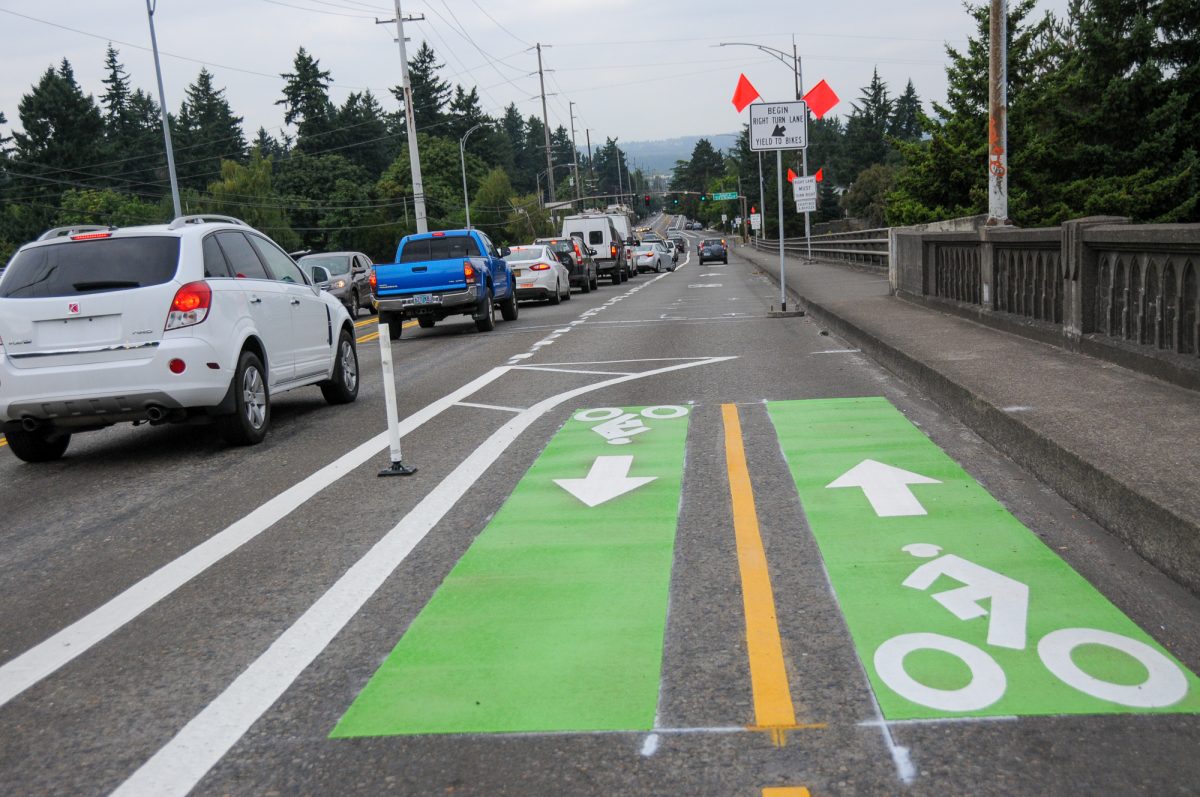
(Photos: J. Maus/BikePortland)
The Portland Bureau of Transportation recently completed phase one of a $331,000 project on Northeast 102nd Avenue that included new lanes for biking, fewer lanes for driving, and more. It’s part of a significant update of the corridor between NE Sandy and Weidler.
This section of 102nd is on the city’s “High Crash Network” list. It was the site of 258 crashes and three fatalities in the five years between 2012 and 2016. Like much of their work in east Portland these days, PBOT’s goal with this project is to tame a wide arterial known for fast and dangerous driving while adding better access for walkers, bicycle riders and transit users. Prior to this project 102nd had a cross-section that included seven lanes of driving access: two for parking cars, two for through traffic, and one center turn lane. The new cross section has swapped two of those through lanes for cycling-only lanes.
In addition to the restriping, PBOT has installed four new crosswalks.
The northern section of the project is pretty standard. The new bike lanes are buffered and they feel nice and wide. There’s room to ride away from the door zone on the right and drivers on the left. Unfortunately the bike lanes offer only paint for protection. (Unlike other recent projects the city didn’t opt for a parking-protected bike lane.)
As I biked south from Prescott the bike lane ended at Fremont (upper left photo). It took a few seconds to figure out what I was supposed to do. I noticed a “Use Sidewalk” sign and found a beg button on the southwest corner of the intersection. I used the signal to cross safely to the east side of the street where I found myself on the sidewalk going southbound (against traffic) over Interstate 84. Then I saw the two-way (a.k.a. “bi-directional”) bike lane that begins about mid-span on the overpass. PBOT has yet to build a ramp down to it, so I lowered myself down a big curb to give it a try.
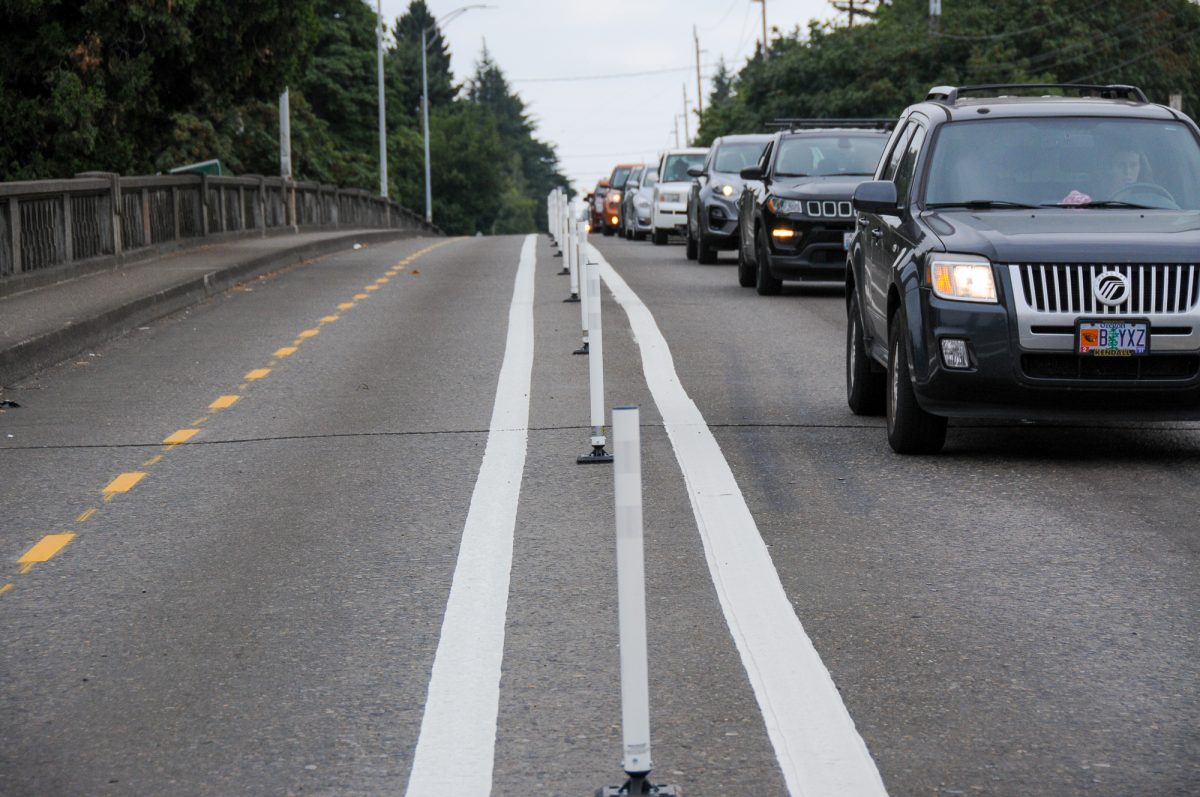
The two-way bike lane felt nice and wide as I rode against bumper-to-bumper traffic. Then on the south side of the overpass near NE Morris Court, things got interesting: PBOT has installed stop signs (which will be yield-when-safe signs on January 1st) between the two bike lanes at NE Morris Court and NE Morris Street.
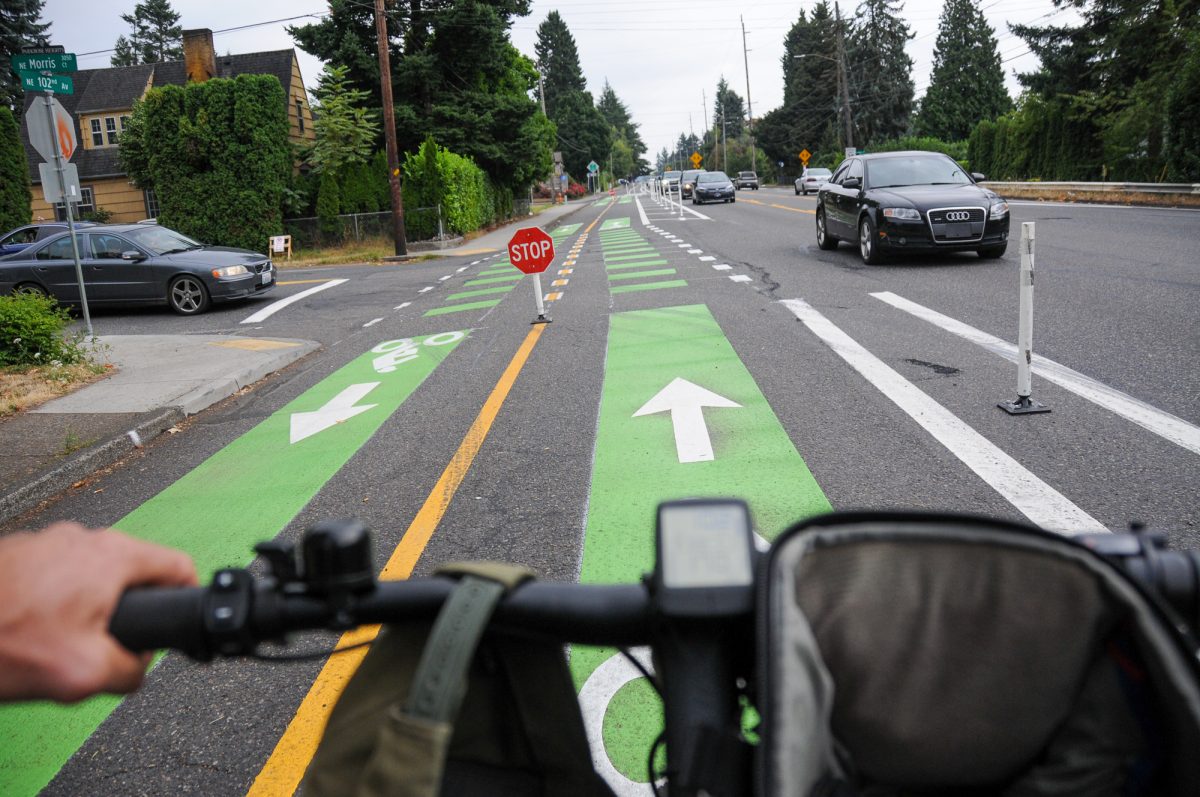
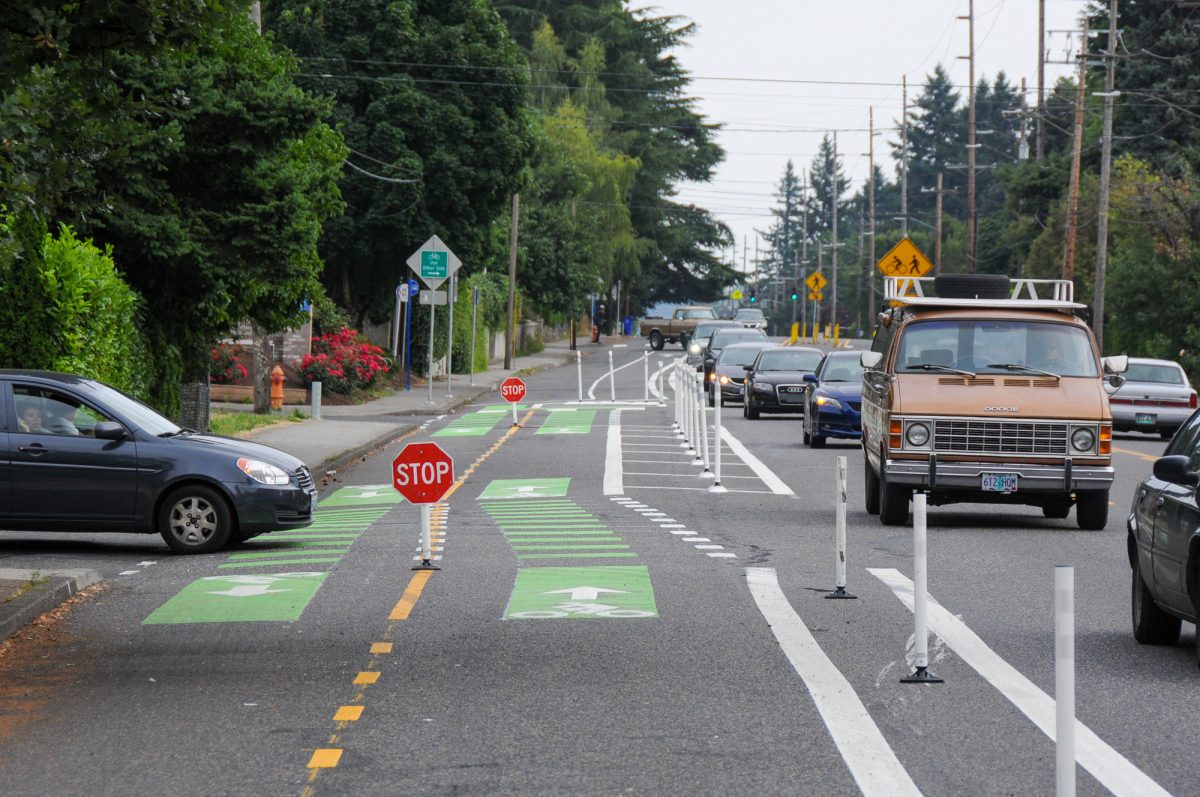
I don’t recall ever seeing stop signs like this before. I was there during the evening rush-hour and as I approached the stop signs there was a lot going on. People were pulling out of a neighborhood on my left, people were turning left into the neighborhood over my right shoulder, and people were turning right into the neighborhood in front of me.
Here’s how it looked on video:
Advertisement
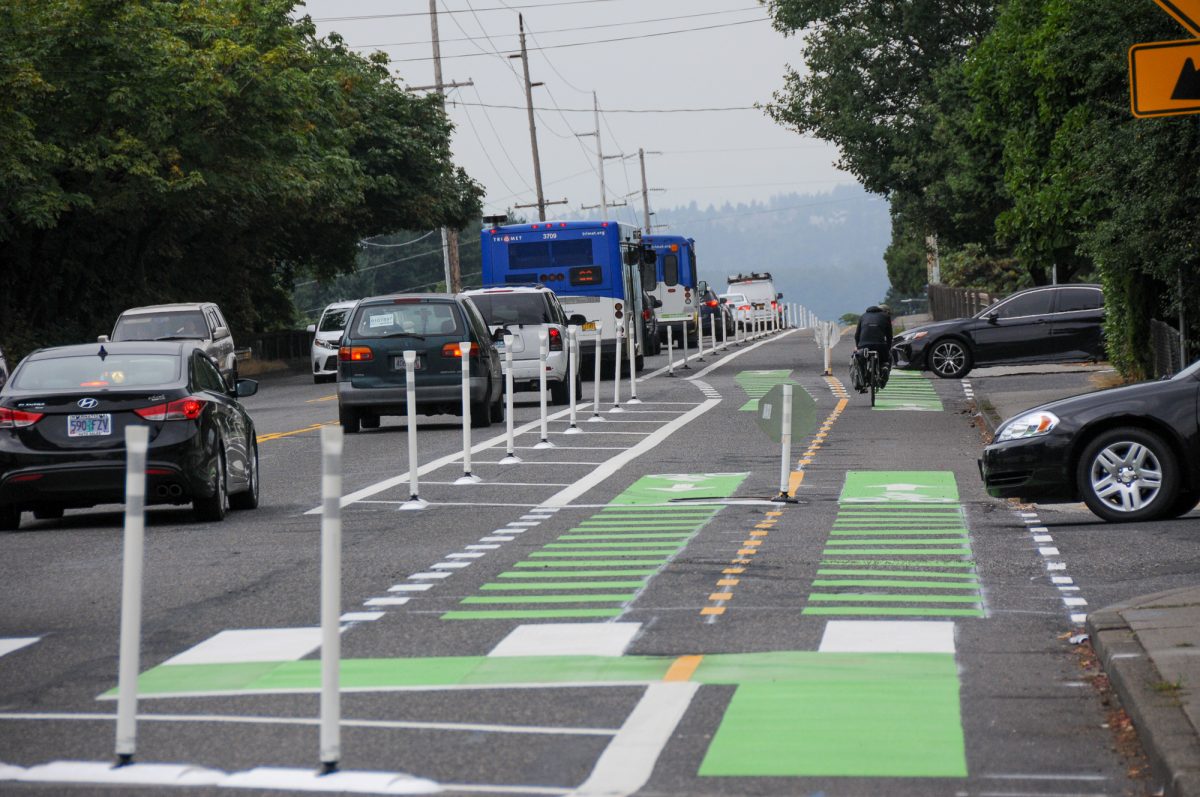
We all know how confused many drivers get when they see a bicycle user at a four-way stop intersection. Now imagine how that plays out in this novel scenario. As always, if everyone is chill and respectful, it’s not that big of a deal. But that’s a big “if”. In the time I observed these intersections, everything worked OK. One problem I noticed, which I’ve also noted at other protected bike lanes around town, is that auto users frequently block the bike lane as they wait for a gap in traffic. Perhaps we need more “Do No Block Intersection” signs?
I’ll be curious to see how this works as more people start to bike here and the green pavement color and plastic wands begin to wear away. On a related note, I won’t be surprised when the stop signs are destroyed by a driver.
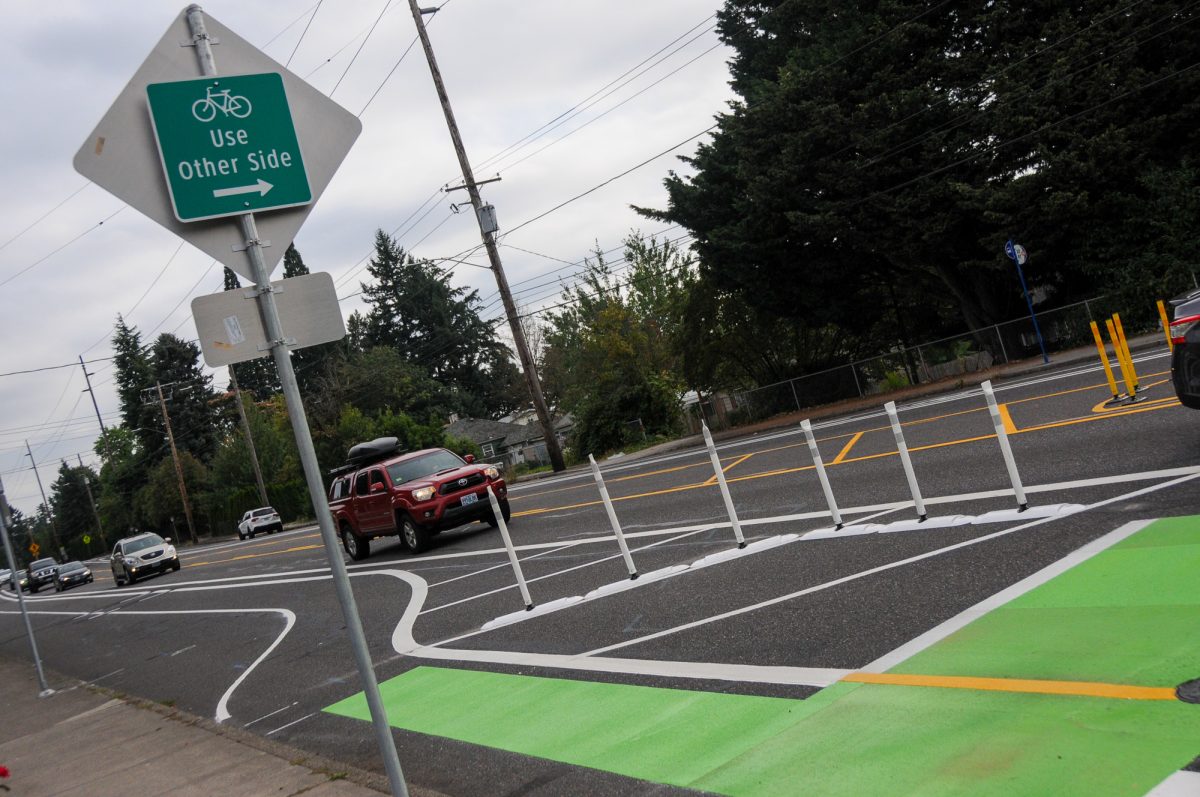

At Morris Street, the two-way bike lane ends and there’s a bike crossing that takes you back to the west side of 102nd to continue southbound toward Gateway. It’s great to have a new bikeway and safer street design that connects to the new protected bike lanes on the Halsey-Weidler couplet. I just wish the connection was a bit stronger. As I approached Weidler, my nice wide lane got narrower and the paint had worn off. The last block-and-a-half before connecting to the new protected bike lane was much more stressful than I had hoped.
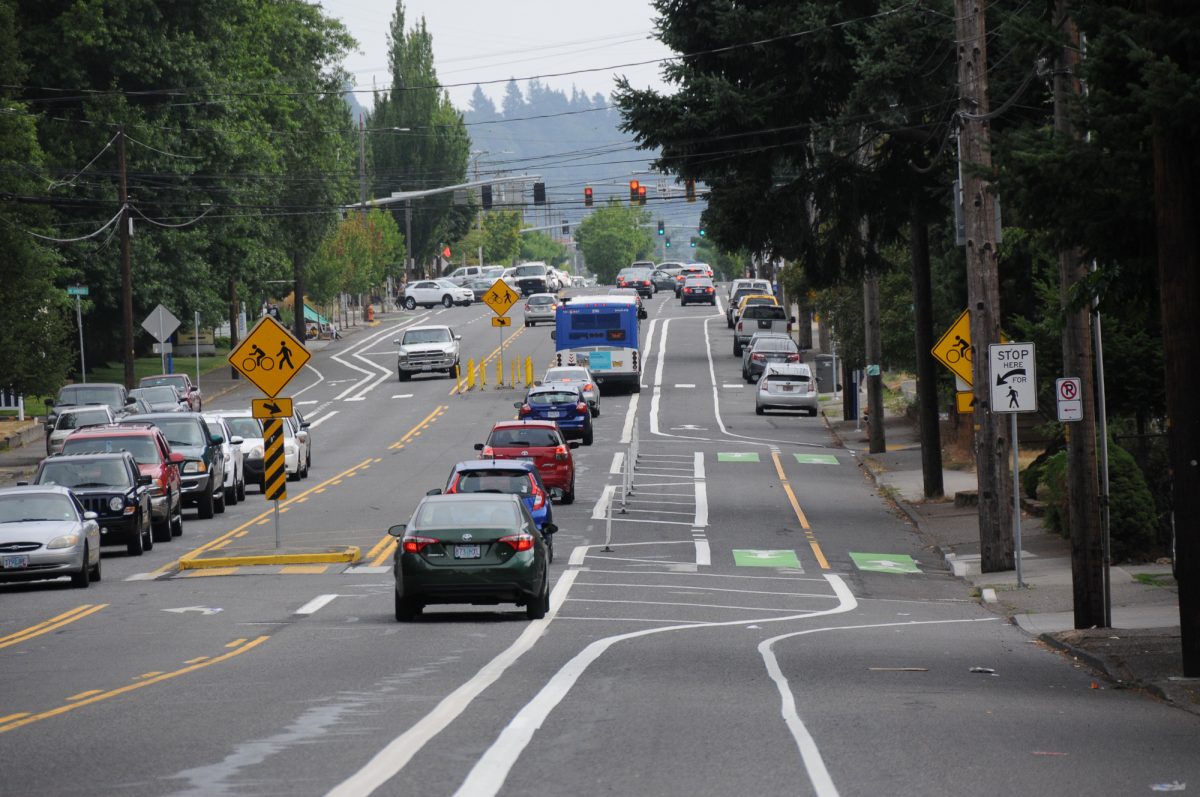
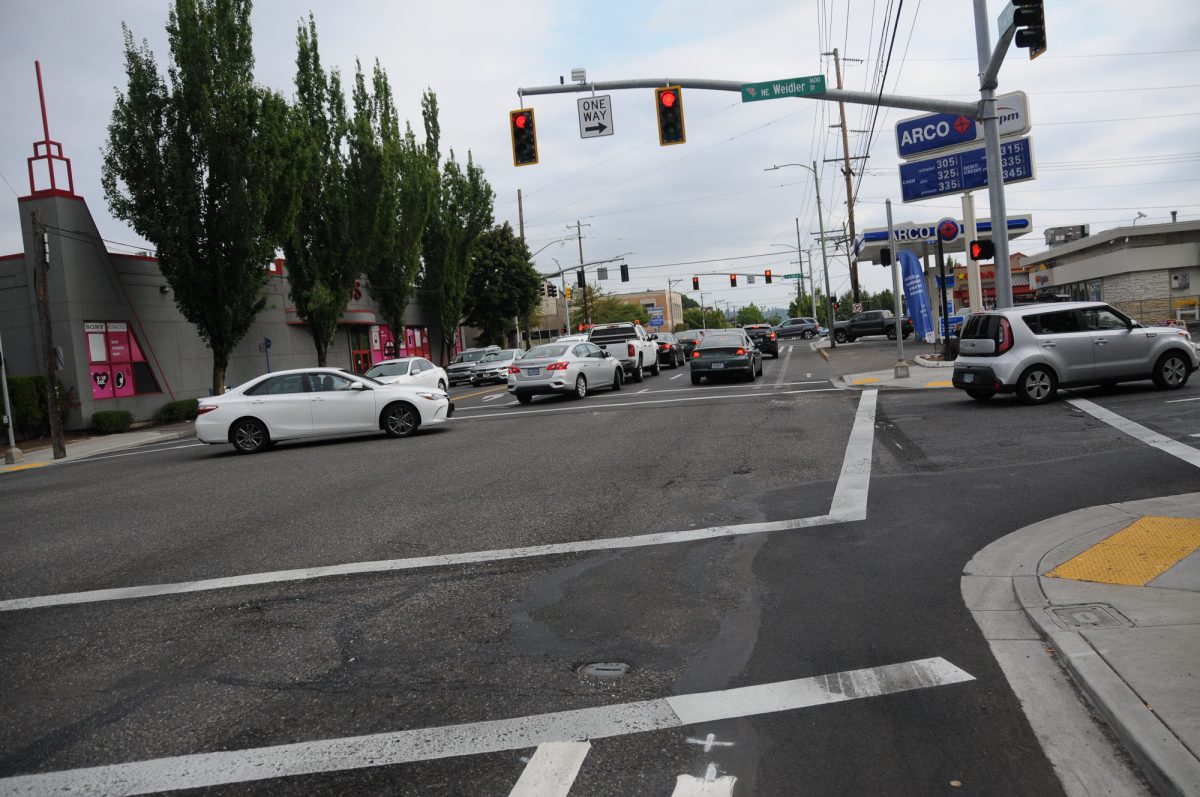
PBOT is still working to complete this project. Later in summer they will add another crossing at NE Thompson, adjust signal timing at Fremont, built that ramp from the overpass sidewalk to the two-way bike lane, and add more bike symbols. The city also plans to lower the speed limit to 30 mph this fall. After everything is done, they’ll analysis traffic data and public input. Here’s what PBOT says will happen next:
“In winter and spring of 2020, PBOT will release a final design based on the project evaluation. If the new roadway configuration is maintained, the design will be implemented in Phase Two, including a crossing at NE Beech Street, converting the crossing islands to permanent concrete islands, adding curb extensions and upgrading curb ramps, adding several upgrades to the NE Fremont Street intersection, and adding any other project enhancements that are included in the permanent design.”
If you’ve ridden this and want to share feedback, contact PBOT Project Manager Christopher Sun at (503) 823-5391 or Christopher.Sun@portlandoregon.gov.
I’ll be riding this again tonight (8/13) with the PBOT Bicycle Advisory Committee during their annual bike tour (starts at 6:10 pm from Franklin High School if you’d like to join) that will be led by PBOT Bicycle Coordinator Roger Geller. Stay tuned for updates.
— Jonathan Maus: (503) 706-8804, @jonathan_maus on Twitter and jonathan@bikeportland.org
Never miss a story. Sign-up for the daily BP Headlines email.
BikePortland needs your support.


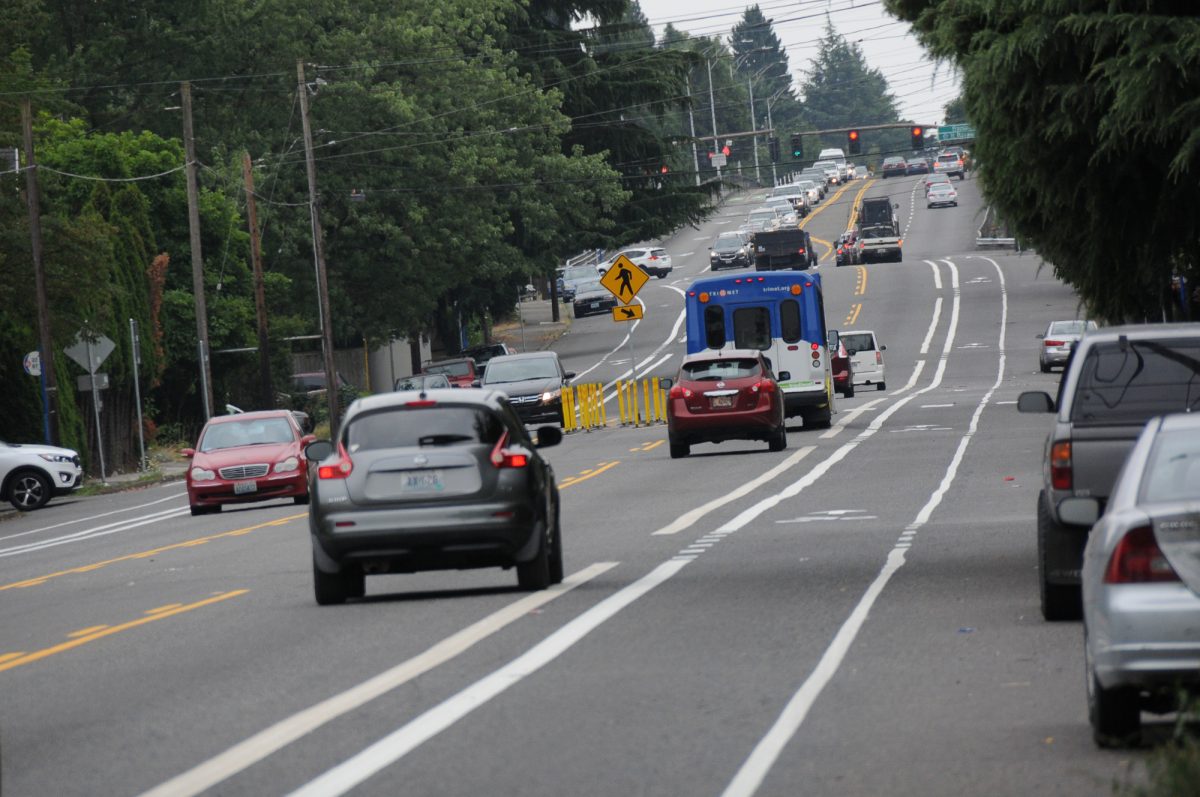
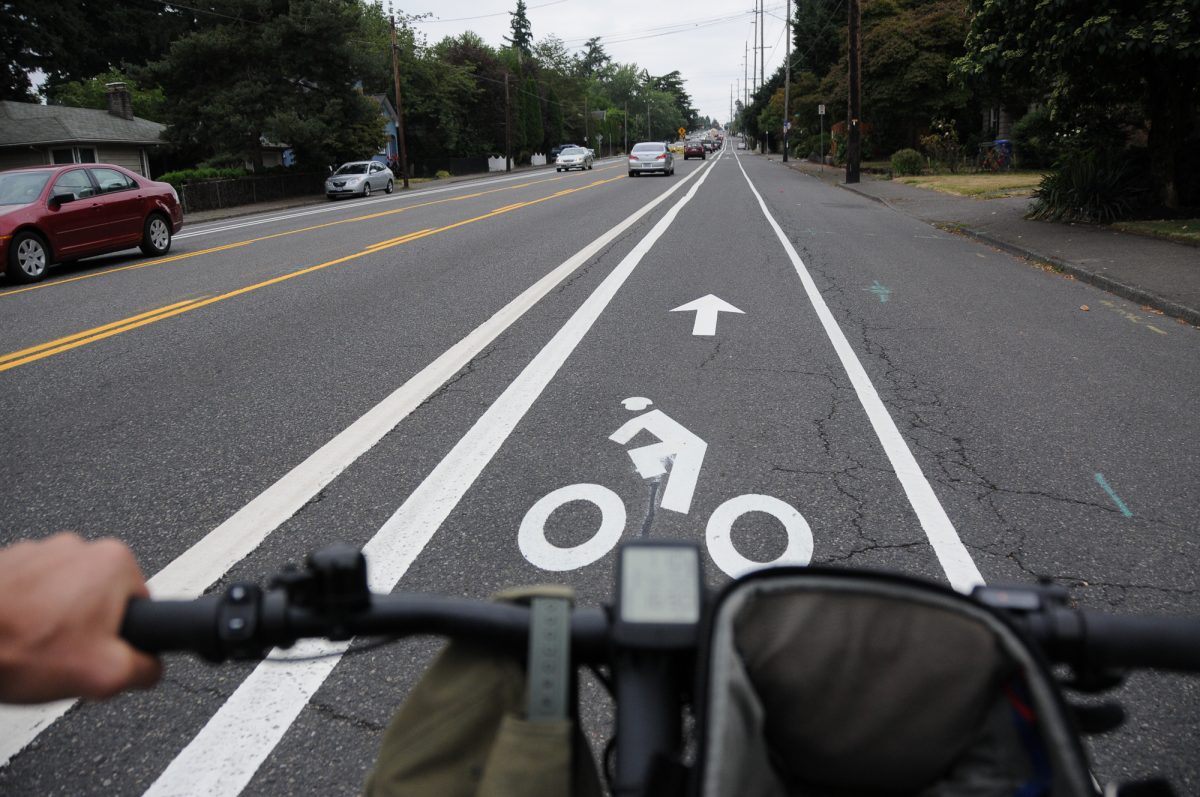
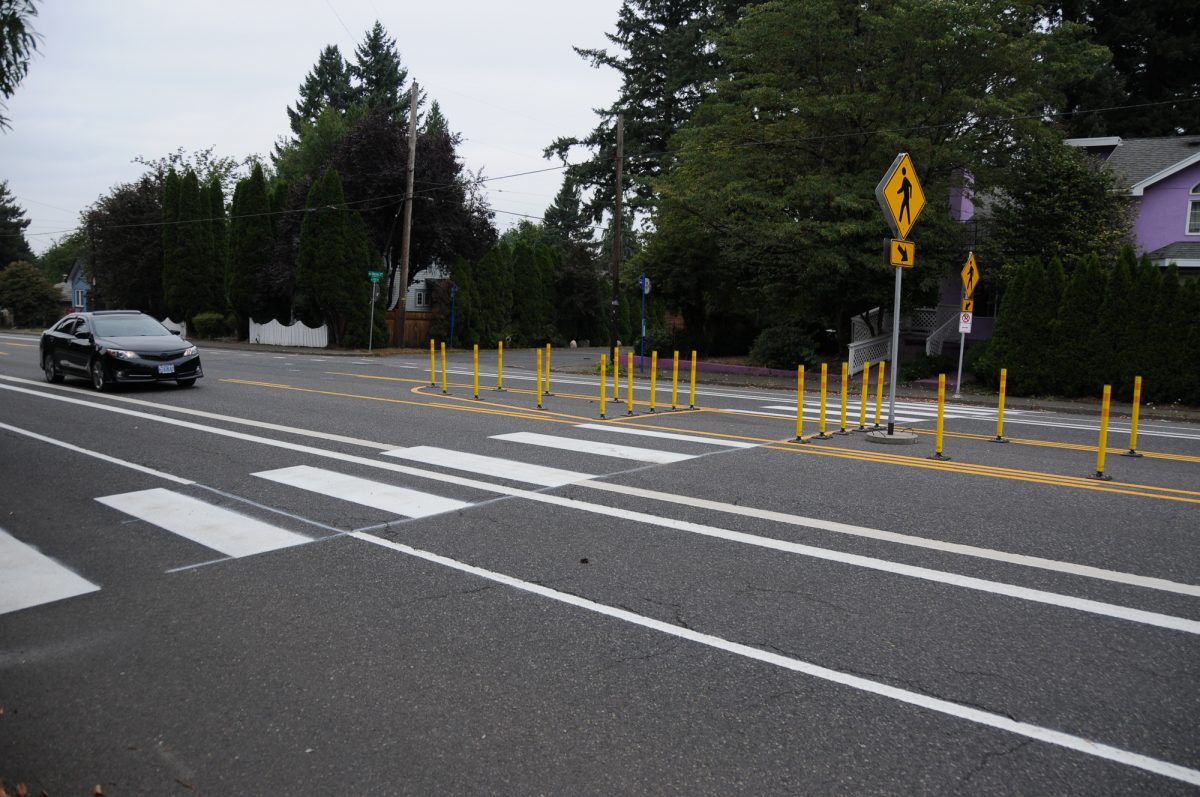
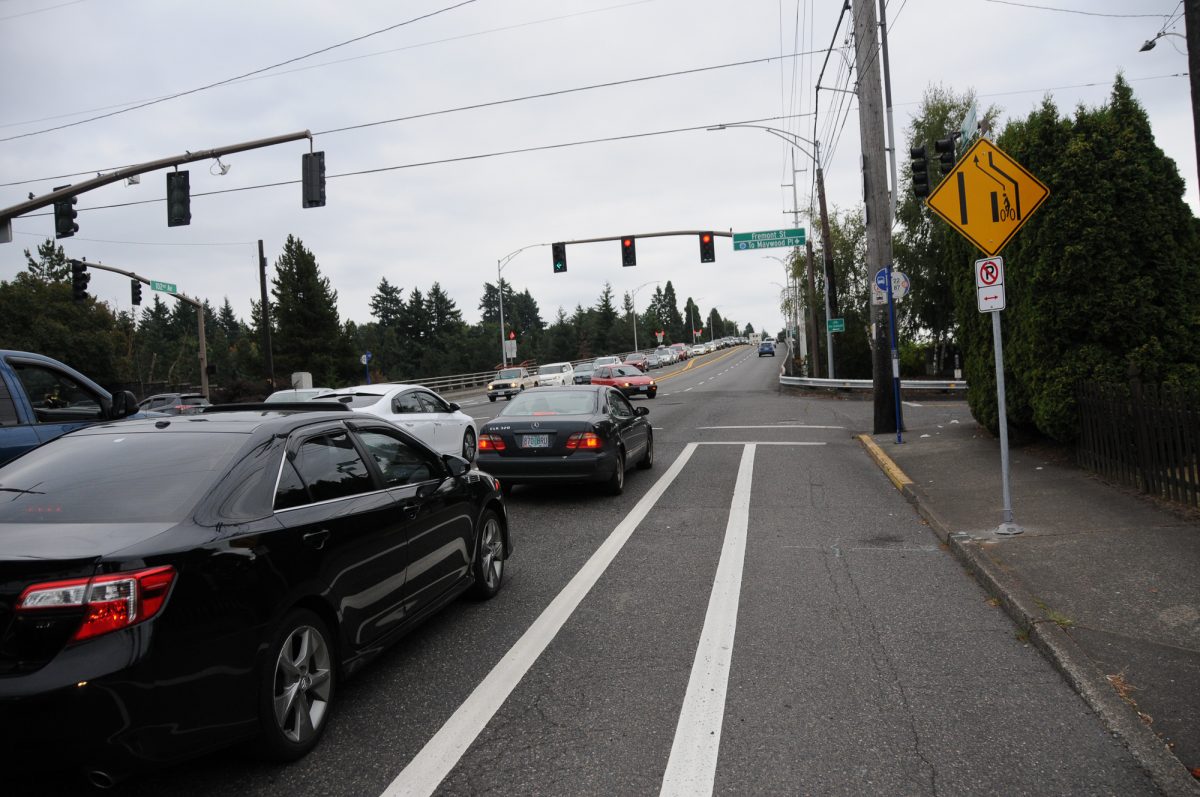
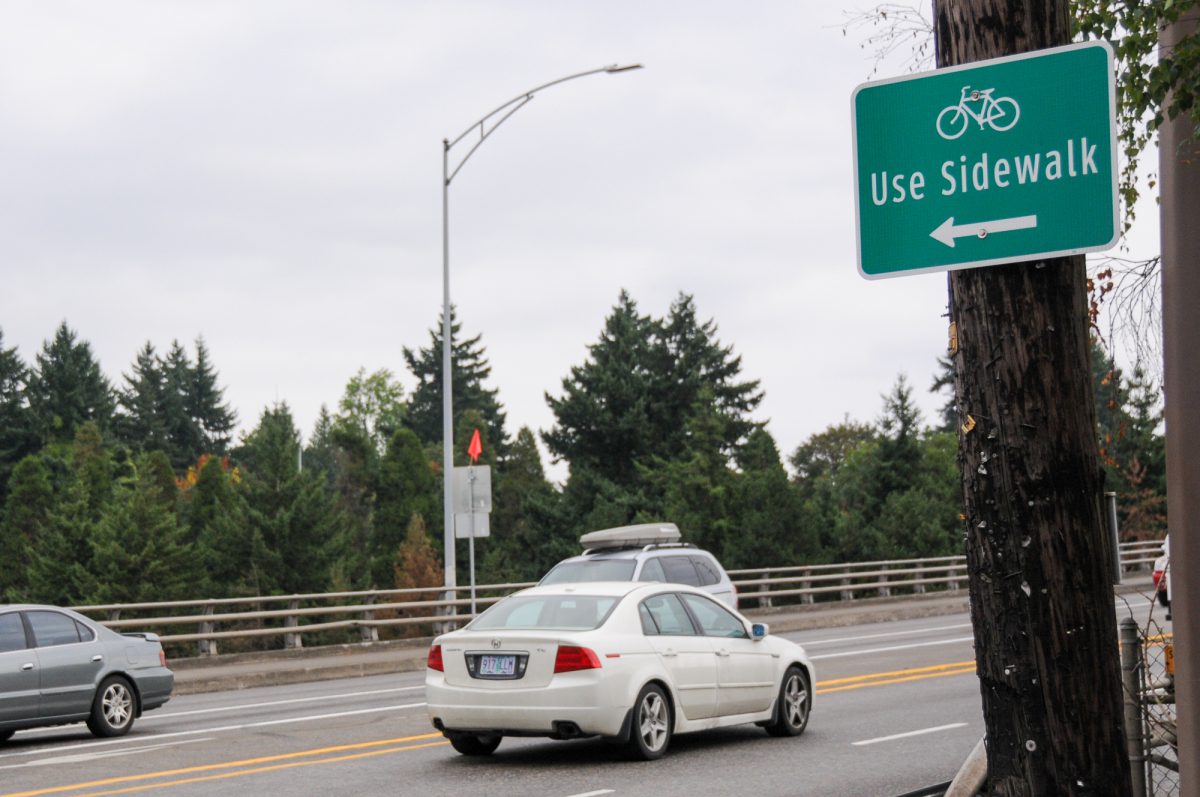
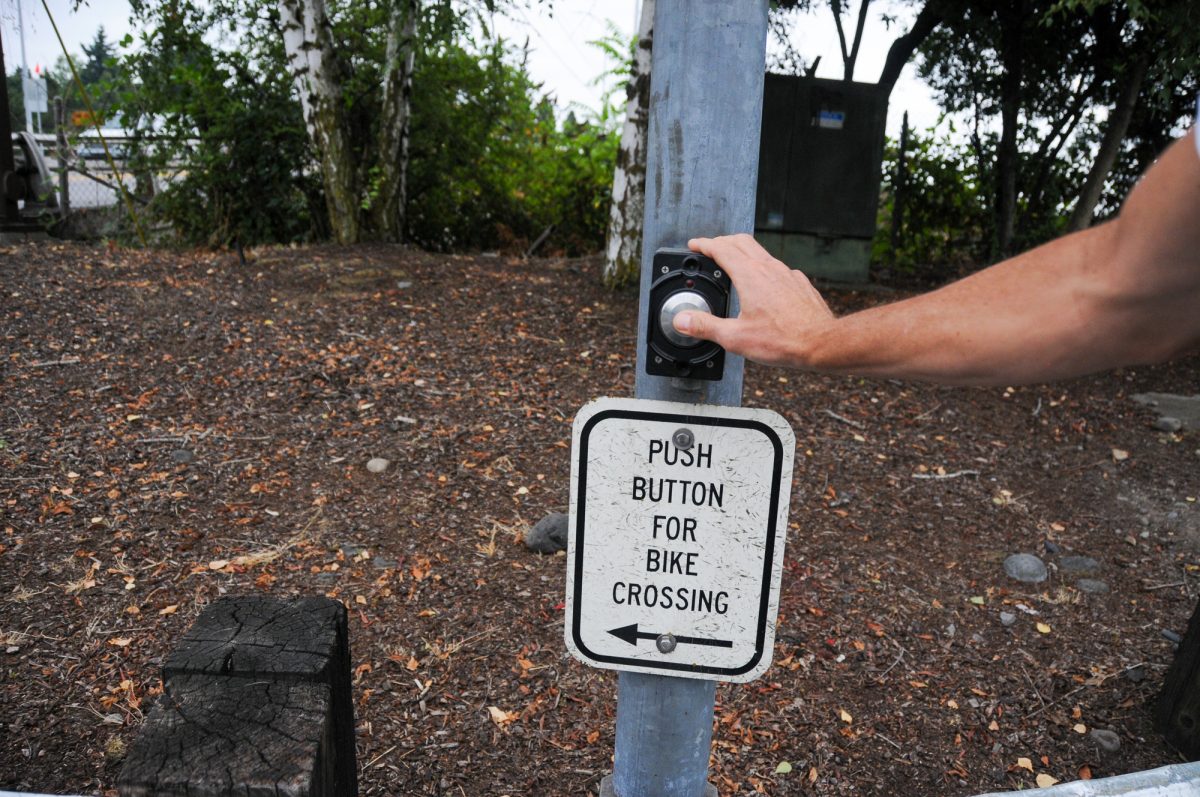
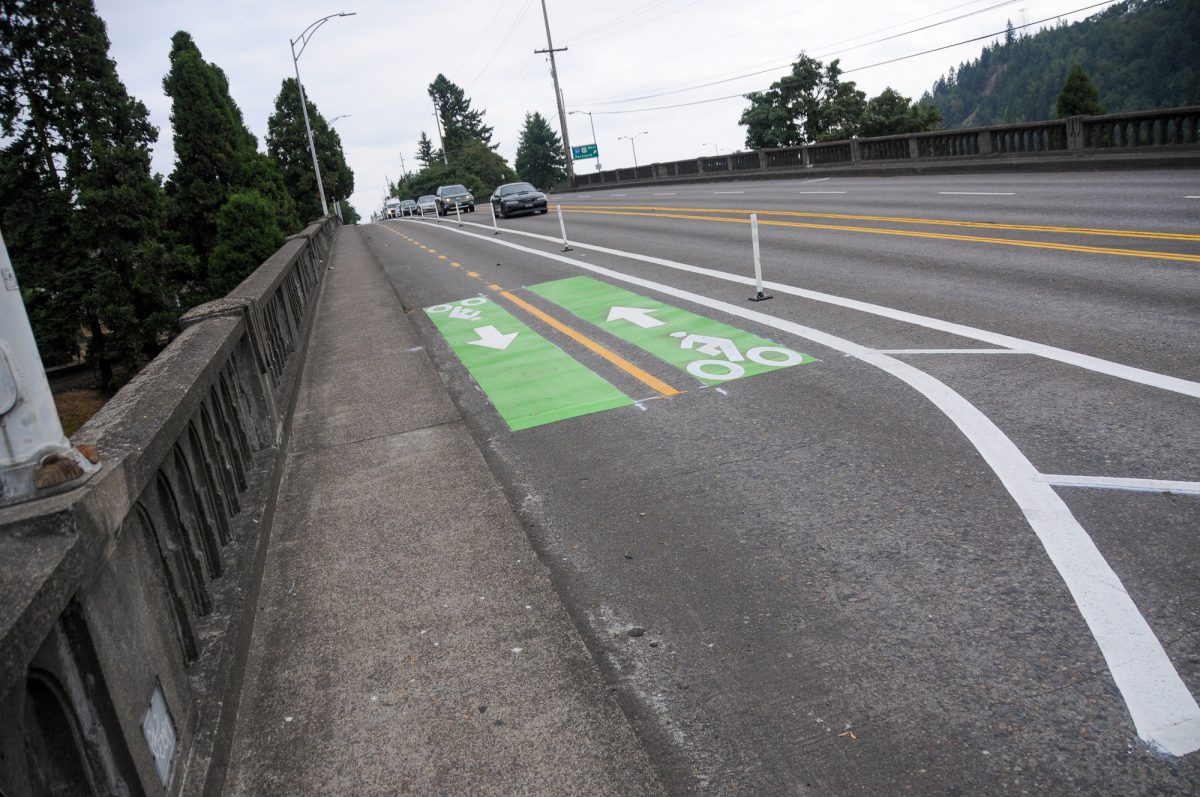
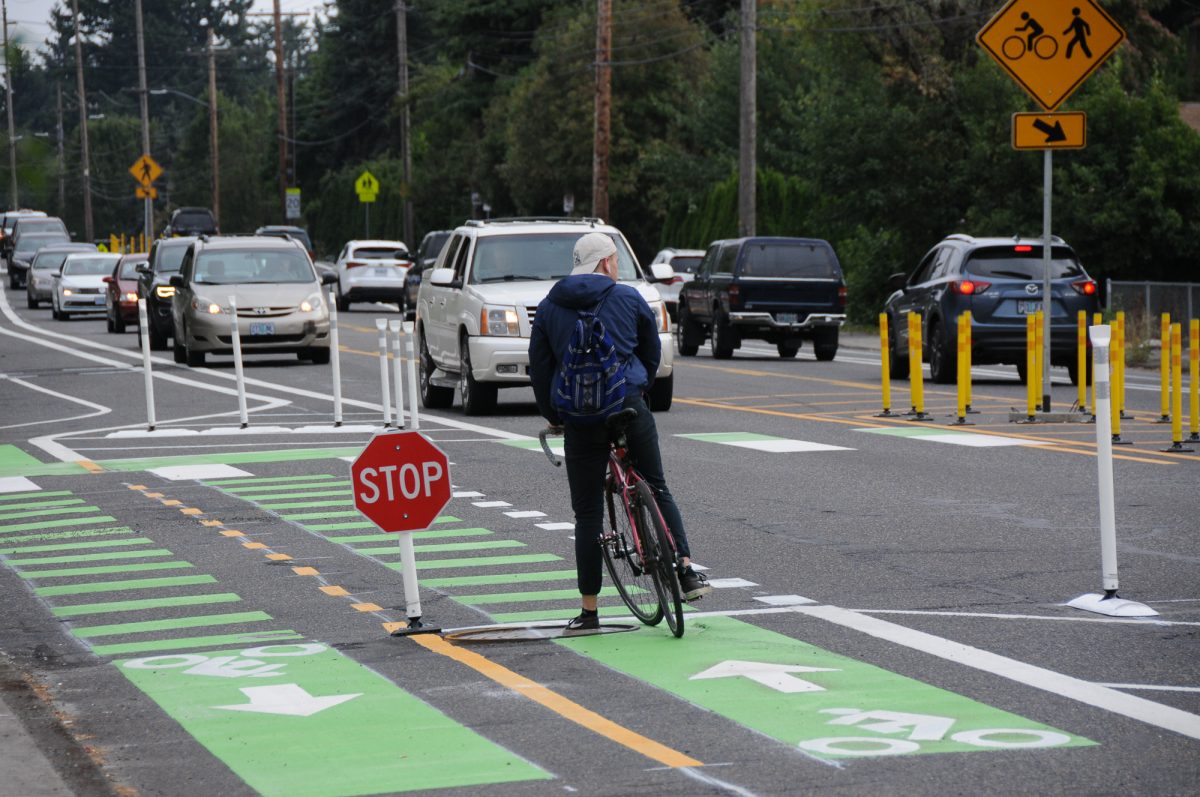


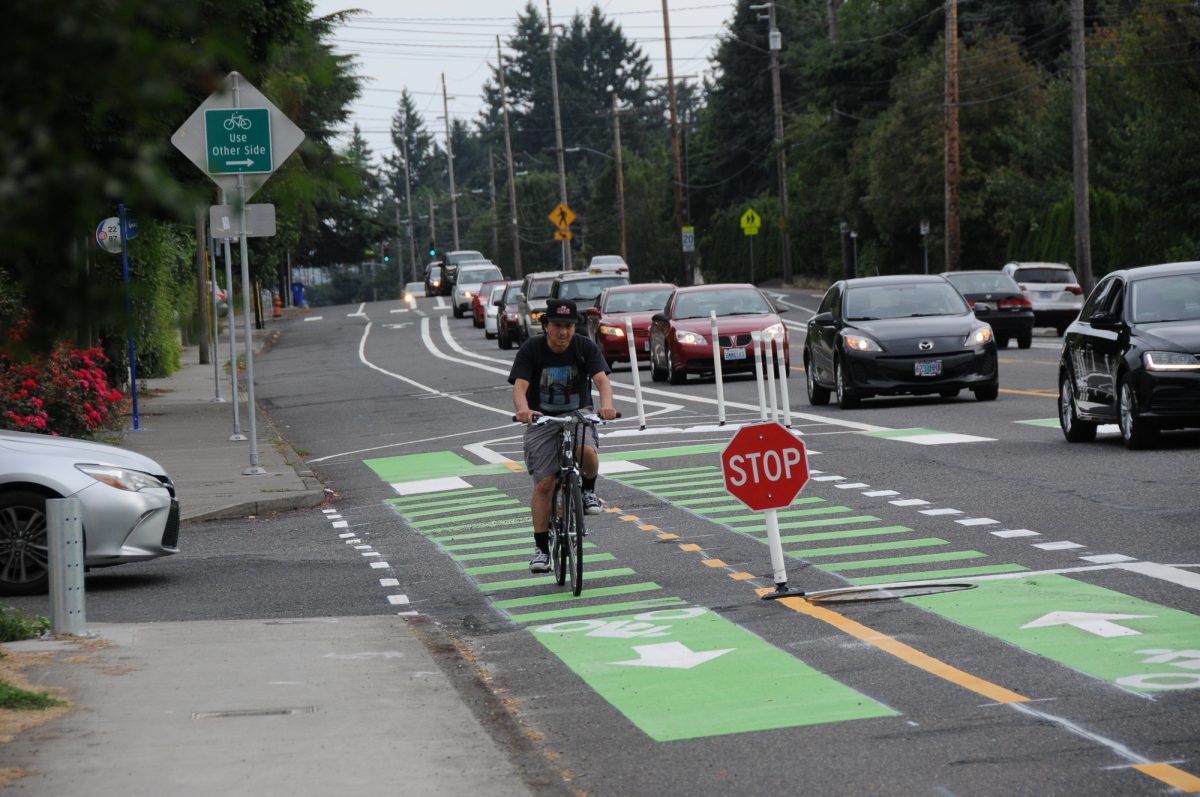
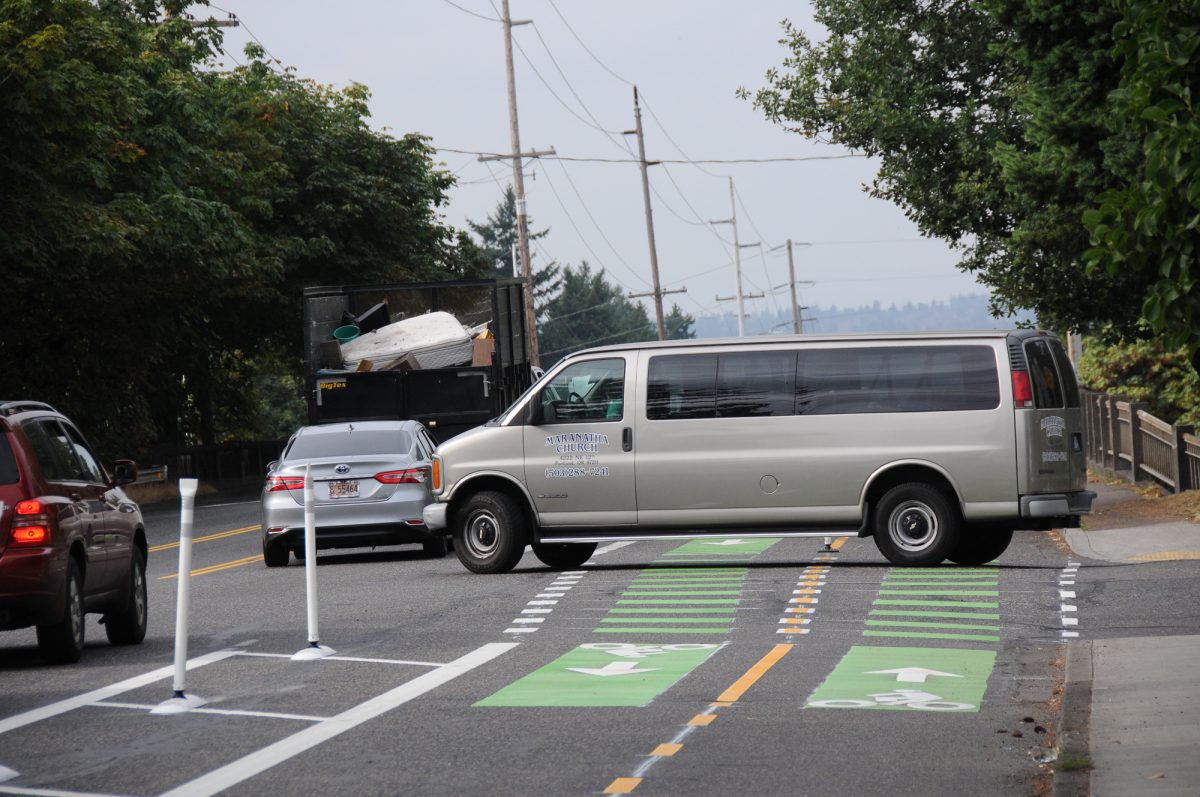
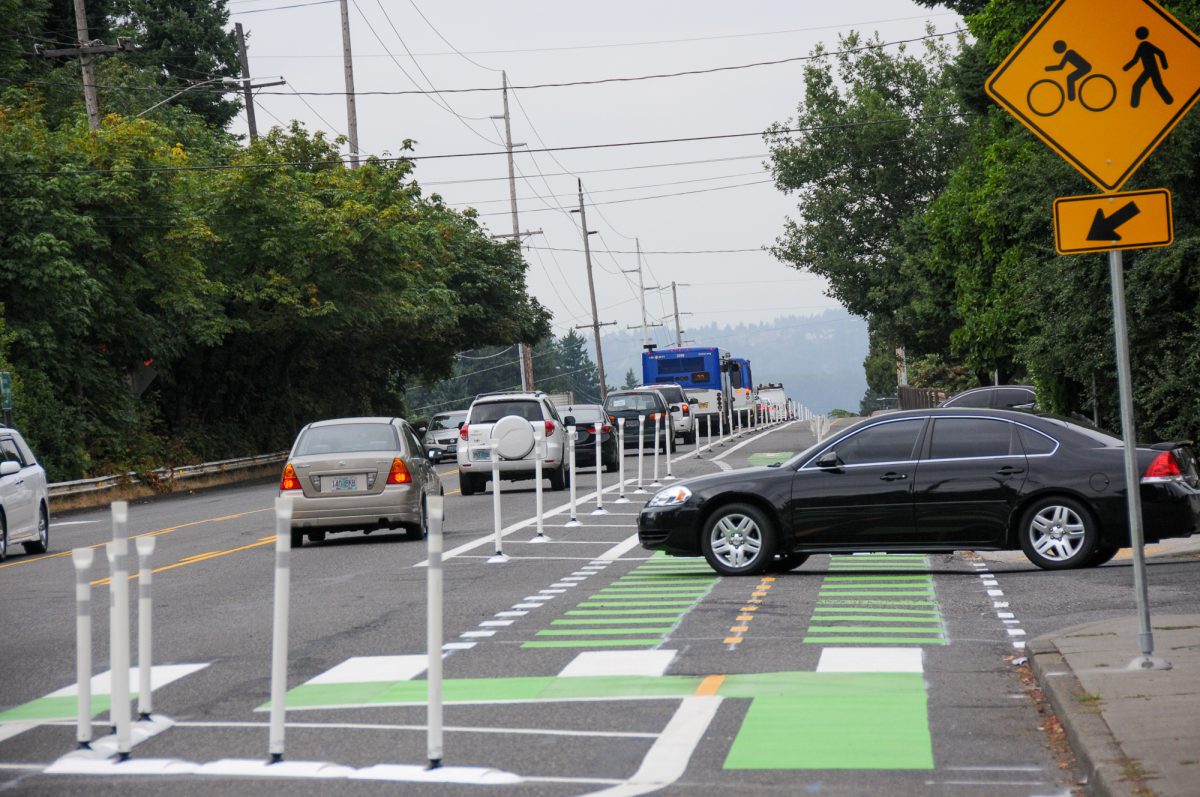
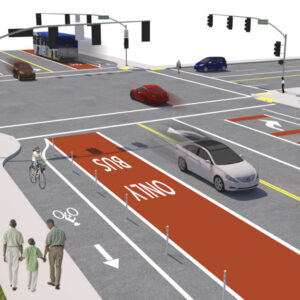
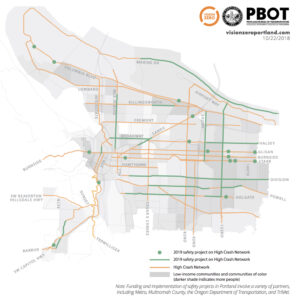
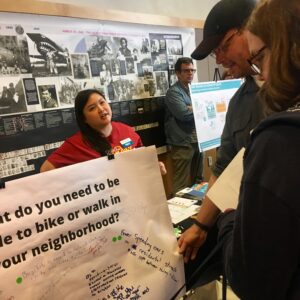
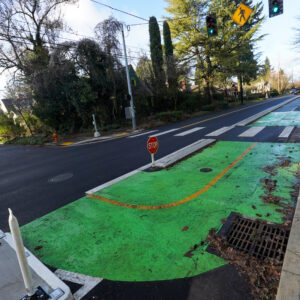
Thanks for reading.
BikePortland has served this community with independent community journalism since 2005. We rely on subscriptions from readers like you to survive. Your financial support is vital in keeping this valuable resource alive and well.
Please subscribe today to strengthen and expand our work.
This a horrible street to bike on before these changes. Unfortunately, all the alternatives are even worse. Looks like everyone was confused by all the changes, which gets everyone to move slow.
This was part of my regular commute for years. I always thought that 102nd was a great way to get north/south *except* for the I-84 on-ramp on the west side of the street. I’m kind of amazed that all this contra-flow bike lane construction has been done to work around a single on-ramp.
Close the highway ramp, problem solved! Would work all over town!
Closing the highway ramps will also result in lots more traffic on the streets we ride on, driven by frustrated drivers. Doesn’t sound so great to me.
I want every driver to be on the freeway so I can have the surface streets to myself!
You let them get on and off the freeway outside the city limits but not in town. Vancouver BC does it (no freeway at all in town) as do many European cities, where the freeways are in tunnels beneath the city. It seems to work for them….Along with decommissioning commuter rail systems across the country, bringing the freeways into the cities is one of the biggest transportation mistakes the US has ever made!
Though not a big fan of drone photography, I wonder if BP should invest in such a thing to cover reports like this? Might be very effective in giving readers the big picure.
Having everyone drive through town on surface streets would still be a huge increase in traffic. It is not at all clear to me it would be better than what we have. We might not have freeways, but we’d likely have more Powells and 82nds, which, I would argue, are just as hostile from an urban standpoint.
No, it doesn’t work up here, at all. Have you tried to move about the Lower Mainland regularly? It sucks, whether by bike or car. Yesterday was a rare drive-to-work day since I planned on heading over to the Tues night races in Burnaby. It took me an hour to get from Delta to New West. Watched a guy ride his commuter by me only six blocks from work, I finally caught him on the Alex Fraser forty minutes later…
I’m not sure why so many people here on this list and in general the “left-of center” politics crowd thinks Vancouver has some type of edge or is the panacea to social ills, it is the opposite in almost every respect. Housing soars to a level that a regular person here will never afford, and the lip service paid to cyclist is pure BS, it’s a sham to make people feel good about them selves and give drivers the right of way. Please don’t hold Canada up as a role model, it doesn’t do any good for cycling. Ok rant over, almost time to ride my 23 miles home now, err I mean my 37 kilometers….
Living there may give you a different perspective from how things are portrayed on Vancouverlandia.
Canada may be too close to have all the answers, but, luckily, Europe is a little farther, and therefore does.
No, I’m not implying that at all, and I understand full well that the ideas PBOT gets from other places don’t always translate well to Portland, and that that’s actually part of the problem. But half-assed execution of weird hybrid experimental designs really doesn’t seem to be helping too much either…
Vancouver is far from perfect, but the bike & transit infrastructure is so much better here than in Portland (where I lived full time from 2004-2015 and part time since then). In some ways though, given how much larger Portland is geographically (145 sq miles) than Vancouver (45 sq miles), it might make more sense to compare Vancouver’s metro area with Portland as a whole. In that case, sure, once you get out of Vancouver proper biking can be a nightmare and Portland by comparison might have more mediocre infrastructure on the edges of the city. I think the main difference is that Portland has so few excellent bike facilities while Vancouver has so many, with improvements coming all the time. Not to mention a much more robust bus & train system.
(And yes, housing is so so so expensive up here, but I don’t think the lack of a freeway through town has anything to do with that.)
No, Van doesn’t have a more robust and proper system. Remember what happens when Skytrain breaks down, for the most part the city stops and it can take HOURS for some to get home. The bus system here is far from being better than PDX and there is one commuter train, the West Coast Express to Mission. Translink is a nightmare, they hired that goof from ST in Seattle to come up and the end result is playing games with switching routes, times, etc that are a result of not fully funding the system to properly move passengers. So when one group or area gets political muscle, some other neighbourhood takes it.
Holding Van. up as a role model really highlights one thing, when one municipality has that much power to wield they inevitably take the screw to the other municipalities. Support for Van equates to basically letting the biggest guy on the block have their way. I’m fortunate in that Delta is one of the better riding spots, way better than Vancouver since I get 15 km’s of riding on the dike for starters, and less traffic too. But the mindset is the same here as anywhere to let motorists roll, get out of my way. A few bike lanes in a city that arbitrarily screws others for its own gain isn’t a role model for how to push forward, it pisses off the rest understandably and doesn’t solve any major transportation issues.
@GNnorth. I think this difference of opinion may have to do with where we live, and I don’t doubt that transit realities are different for those outside the city proper (just this week I had a 30 minute wait for a bus in Richmond, so I know that game). I imagine commuting from Delta is quite a thing! It’s also not clear to me how much time you’ve spent in Portland, but MAX is certainly not a saviour (have you ever been on MAX going through downtown? Zzzzzz).
I live in East Van and my experience getting around the city by bike and transit it mostly positive. Yes there are some gaps in my bike routes, but I can ride from my apartment to Third Beach in Stanley Park (or Jericho Beach in the opposite direction) with the vast majority of my ride on paths that are fully separated or fully protected from cars by concrete jersey barriers. I ride the SkyTrain to Richmond several times a week for work and I love standing on platform and seeing the reader board announce trains ever 2-4 minutes. I can only dream of MAX coming that often. And yes, in the evenings I sometimes have to wait 9 minutes for my train (and yes, I know there is track maintenance that delays service after 10pm), but I think one reason there can be such delay is because of the high demand; I don’t love a standing room only bus or train, but I love that so many people are on transit AND that the city/region is adding more trains buses to meet demand. Again, this may be felt much more in Vancouver proper than in the outlying cities.
Again, I don’t think Vancouver is perfect, but the stats show that more trips here are made on transit than in other cities, including other cities served by Translink. FWIW, comparing transit service in Delta to Vancouver is like comparing service in Forest Grove to Portland.
julie H, totally fair and I respect your opinion even though my attitude may not appear that way. Glad to see that your commute from East Van is relatively easy and enjoyable. I’m not just comparing Delta to Van in regards to Translink, my experiences aren’t so positive systemwide As for MAX, I still like taking it every time I’m back in town (used to live on NE Killingsworth and also King City down south) and I agree it has issues, but still better than Skytrain imho. While the view may be nicer headed out to YVR vs. PDX Intl. the ride is better on MAX and when there’s space at least I can bring my bike. Can we do that now to YVR? I try as little as possible now to go over to the other side of the river, hard to believe I like Delta over Van, ugh.
Just proves the point that so many bicyclists really do not care about well being of many outer Portland’s poor residents, as long as they can stick it to drivers. Spend all that money to make traffic much worse to appease people like you.
City will do whatever bicyclists want. If it actually is smart or helps the city is second consideration.
Typically if you are riding along and see odd junk (green paint,bollards) it’s time to just take the lane.
I certainly agree that often the best response to inventive bike infrastructure solutions is to take the lane (Downhill bollarded door-zone bike lanes? I’m looking at you SDOT). Unfortunately I don’t believe Oregonians have the option to take the lane when a bike lane has been provided.
Maybe the law has changed.
I’ve looked at those pics several times, and can’t figure out how it is supposed to work. Is a stop sign for a single lane of a street that otherwise has priority part of the MUTCD?
The stop sign at Morris Court (the first one south of the bridge) is there instead of a 3-way signal, as Morris Court is effectively an east-bound offramp for I-84. Weird but true. The second stop sign at Morris Street is for the transition of a two-way bikeway to 2 one-ways, according to a PBOT pdf of the project design.
I need a drink of whatever PBOT has been drinking lately. When things are confusing, vulnerable users lose.
Just don’t drink as much
Are there any plans to add reflectorized RPMs in the buffer part of the bikeway…so that the bikeway section (without wands) is usually distant from the MV roadway at night during the fall winter?
Who do we blame for this crap?
Enough is enough, bike share is not going up in this city despite thousands of new residents who obviously are not riding bikes.. Spending stupid amounts on green paint just so someone can look like they are doing something is not helping at all.
It is time for a complete overhaul.
Someone at PBOT needs to make sure that the water filter also removes lysergic acid diethylamide.
SW Garden Home Road had stop signs for people riding a bike on the north side of SW Garden Home Road from SW 78th Ave to SW 92nd Ave. Those signs are gone and it now has a lower speed limit in that section.
I thought of Garden Home Road in that section when I saw this, too.
Since car drivers don’t always signal, on Garden Home Road, back when they had the stop signs, you effectively had to wait until there was no traffic on GH Road in either direction before proceeding. Otherwise you (or your heirs) would be arguing to the authorities, and the motor vehicle owner’s insurance company, that you had not properly yielded to a turning driver.
And as in the video, what if there’s a stopped driver coming from a side street? Does the bicyclist have to yield to the driver if the driver got there first, except the bicyclist can go ahead anyway if the driver can’t go because of cross traffic, except that the bicyclist probably shouldn’t go either if there’s cross traffic because of the point I raised above?
This is exactly the kind of mickey mouse that came to mind. What does a stop sign in a contra-flow lane sandwiched between two other lanes that have no such stop sign even mean? Who has what right of way when and why? The presence of the “crossbike” paint makes things even less clear; if a cyclist has arrived at the stop sign along with a car, does the car have to stop for the cyclist that stopped for the car? Who can even go at that point? Not the car, because it has to yield (unless it doesn’t because no one really knows whether a “crossbike” has any legal meaning, especially here where it doesn’t connect anything remotely resembling corners, which is part of the definition of a crosswalk, which in turn enables the “crossbike”… maybe). The bike can’t go, because it has a stop sign and the car doesn’t. So the car has to yield to one of the bike lanes and the automotive lane, but not to the other bike lane. Can the car pull forward into the bike lane as the driver is waiting to turn (as one driver in the photo above has done)? What if they are exiting 102nd and block only the bike lane that has the stop sign? What does that dashed white line along the curb mean?
So many questions. If there are any PBOT folks lurking here, please help explain how this is intended to work.
Wow. This is, unfortunately, what happens when “Street Designers” attempt to “fix” roadway issues for bicyclists. This design (the two midline STOP signs) creates undefined legal territory. Drivers on the side street have a STOP sign, and one lane of the main roadway has a STOP sign, but all other lanes on the main roadway need not stop. The protection afforded by bike lanes in the actual law (ORS 811.050) is countermanded by these stop signs:
1) Suppose a turning driver hits a bicyclist as they cross in the STOP-controlled direction? Is that a)
failure to obey a traffic control deviceimproper entry into an intersection by a bicyclist, b) failure to yield to a rider on a bicycle lane by a driver, c) who knows? Let’s argue about it!2) Now imagine the same thing happens to a bicyclist in the non-STOP-controlled bike lane…
There are any number of other scenarios where “common sense” navigation of this infrastructure puts drivers and/or bicyclists into legal limbo.
If it needs to be explained it doesn’t work.
Perhaps not as egregious as this example, but the same sorts of idiotic bike lanes have been installed for cyclists at plenty of other locations in Portland, such as NE 20th and NE 28th where they cross I-84, SE 30th at Stark, go ahead and add you favorite location to the list.
Once the city creates these types of ‘facilities’, it’s time to ride somewhere else!
Finally, PBOT found something where cyclists, auto drivers, and pedestrians can all unite. We can all unite in scratching our heads and wondering WTF at this monstrosity.
This is a huge improvement. This street was insanely dangerous to ride on before these changes. The closest I’ve ever come to getting put in the hospital was crossing 102nd at San Rafael. Car in the right lane stopped for me, and right as I started crossing, a car behind them illegally changed lanes and almost hit me. Getting the street down to one lane each way is the big improvement here.
never trust the driver in the next lane over. and I’d rather let the motorists clear the intersection first, I almost never go if I perceive the motorist as having the right of way, that’s why the ‘cross bikes’ are so infuriating, no legal status, but some motorists are compelled to try and ‘give’ you the ROW, even if you don’t have it. If I’ve got a stop sign, I just wait and ignore them, or point to the sign if it gets too tedious.
“(a ramp from the sidewalk to the new lanes will be built later this summer)”.
How stupid do they think we are????!
I commute to work on the Eastside and have mostly avoided 102nd. Since the change I’ve ridden it a few times, and while it isnt great, it’s a whole lot better than it used to be. The biggest disappointment I have with this iteration is that the ramp to the sidewalk wasn’t built from the get-go. That means either dismounting to step off the curb(its pretty tall), or keep riding the sidewalk until Morris. I’m not a fan of the stop signs either, it adds a bit of ambiguity where there need not be.
Is there any reason pbot decided against making the entire project 2-way bike lane? I understand why it needs to be that way at the I-84 overpass, but to me it doesnt seem unreasonable to have the whole thing run two-way, on the east side of the street it would link up much nicer for cyclists using the halsey/weidler couplet as well.
“Keep Portland Weird” was taken perhaps a bit too literally here.
But thx for the lol PBoT!
I have a question about the “Looking south toward Halsey-Weidler” image- is that about 50 feet of 2 way cycle track you have to cross the street for and then immediately jump back over to the other side?
It reminds me of something similar, though slightly longer, on Killingsworth.
It makes more sense when you see it in plan (https://www.portlandoregon.gov/transportation/article/709830) and in context of the bike network (https://www.portlandoregon.gov/transportation/article/322407).
If you are already on the east side of NE Tillamook, heading north, the bikes lanes are continuous and there’s no need to change sides of the street. If however you’re heading north from NE 99th and trying to get to NE Tillamook via NE Bell (as suggested by the bike map) the 2-way section lets you travel on north on the west side of NE 102nd, up to the crossing at NE 102nd and Tillamook. This removes the “Difficult Connection” red lines currently shown on the bike map.
Nice, thanks for the context!
As a bike safety instructor for middle schoolers in this area I’ve got my work cut out for me when teaching how to navigate this. So according to the rules of right-of-way a car heading southbound is turning right across this two-way bike lane they have priority over northbound cyclists, but not over southbound cyclists. If a vehicle turning onto 102nd from one of those side streets gets to the intersection before I do, I have to wait for them to execute their turn before I can proceed through the intersection (as evidenced in Jonathan’s video). This is kind of a mess. Any idea why they didn’t opt for two separate bike lanes? Was it a space thing over 84?
What’s going on in that picture with the caption, “Looking south toward Halsey-Weidler”? Is that a two-way bike lane for exactly one block?
Yikes
The 102nd bridge over I-84 is/was four lanes, plus a sidewalk on the east side.
PDOT could have put a bike lane on both sides and still retained three lanes.
The problem is that there’s an on-ramp to I-84 west on the west side of the bridge. Cars trying to get on to I-84 westbound would have to cross the bike lane to do so. Moving all the bike traffic to the east side of the bridge avoids that conflict.
And there is a concrete median. To reduce it to 3 lanes, they would have had to remove this median and likely re-pour concrete to re-establish a smooth center lane. People on here would rather just complain than spend a little time to understand the factors at play here.
This is almost always a *good* thing, ATMO. Sadly, PBOT has recently moved away from engineering bikeways for the non-elite uber-experienced rider (e.g. the SW Madison buffered bus lane for bikes)
Ah yes, Madison was way better when there was the daily opportunity to get right hooked. It is so much better now, and if someone isn’t confident, there is nothing that requires them to pass a bus, just stay right behind it and go on down the road.
So, just to be clear, when we say “vehicular cyclists”, does it mean “bicyclists who are experienced enough to know when to operate like other vehicles (possibly in spite of the presence of dangerous infrastructure) and are usually not afraid to do it”, or does it mean “grumpy bicyclists who think any and all special infrastructure is for sissies and everyone who rides a bike should just man up and take the lane already”?
I consider myself the former, and crappy infrastructure that makes my life harder is most certainly NOT a good thing. ATMO.
Thank you Biciclero for at least recognizing the former is a possibility; it feels as if for years the “bicycling community” has assumed the latter is the doctrinal definition and newspeaked the word entirely.
With all the expanse of asphalt on 102nd, it’s unbelievable that a direct, convenient and safe route couldn’t be designed. Moreover, I couldn’t help but notice your photos showing buses caught up traffic. What a missed opportunity create a complete street that addresses all modes.
Jonathan, can you ask why they opted for travel lane, bike lane, parking instead of PPBL?
It seems like the parking lane is 8 or 9 feet, and the bike lane is 6ft + 2ft buffer, so the total width of 16-17ft is enough accommodate PPBLs.
I do understand people’s hesitation with visibility, but that can be accommodated with parking setbacks / daylighting. Currently though, I’m worried about drivers using the bike lane/parking lane as a turn lane (like what happens on Foster)
FWIW I don’t think there is anything wrong with motorists using the bike lane as a turn lane. When I’m on my bike I don’t want to pass right-turning traffic on the right, regardless of whether I have a legal right to do so, it’s incredibly dangerous. When I’m driving I don’t want to worry about cyclists passing on my right when turning, I’d rather merge into the bike/parking lane and let the cyclists pass on the left. If you don’t drive like a jerk, it’s not hard to do this safely.
I see the merits of this method for avoiding right hooks. In theory it makes sense. My experiences with this in the US were too often unpredictable situations where some drivers would do this, but many wouldn’t. The same was especially true with either the bike lane crisscrossing with the right turn lane for cars or the merging situation. In practice, I would end up having to be extra careful even when I had priority. For this same reason of lack of predictability, I always really disliked the “no turn on red” intersections, since only half the motorists would actually follow it.
The merging of the bike path/right turn lane is actually quite common in Copenhagen. At least there, the vast majority of drivers are very use to the mass of cyclists. So it can also work in practice, but it’s still not an ideal situation in my opinion. You also have to rely on the merging motorist to be paying sufficient attention. In the city center, you can also get stuck behind a right-turning car for quite some time while that person is waiting for all the pedestrians to cross.
Although I’m happy to see the new 102nd and Halsey/Wielder bike infrastructure, for those people using the I-205 path going north and south, the 102nd Avenue bike lane is redundant because the two bikeways run parallel and in some places are only about 300 yards apart. In fact, my first impression was that the 102nd bikeway was a waste of money because of this. Between Gateway and Marine Drive I will always take the I-205 path only because there are no cars on it. The only real value of the 102nd bike lane is putting the bike lanes over the I-84 bridge. This will make it safer for those cyclist coming out of Fremont and heading southeast or vice versa. If, for example, I was on Halsey at 122nd and was heading toward Marine Drive by way of the I-205 path, I would ride on the residential streets only to get away from the auto traffic on Halsey/Weilder and 102nd. As I live near Rocky Butte and as I ride to Vancouver via I-205 a lot, it is not likely that I will ever use the 102nd bikeway. IMHO the money would have been better spent putting bike infrastructure on a place like the St Johns bridge.
Much like outer-Holgate, this project is mainly being done to put a lower-traffic stretch of 102nd on a diet. Eliminating the extra lanes will greatly reduce dangerous speeding. I ride or drive this every day, and it has been a huge improvement. This once was the most stressful crossing on my ride from Hollywood to Rockwood.
This looks to be a total shitshow. I’m speechless.
I live out here and all this SUCKS. Now we have backups from Halsey to Sandy on some days, making it hard to get in and out of the neighborhood on streets like Sacramento for example. You have people shooting in and out at any opportunity and it is definitely worse than before. Epic fail PBOT. Sorry there weren’t enough bike riders out here to warrant this.
build it and they will come, anyone?
The SW Washington drones will eventually find another preferred route as their queue for the 205 bridge.
Roger rules.
PBOT tops itself once again with a design that’s confusing to cyclist and drivers let alone dangerous. I live in the area and will not ride this path and now have to find a new north/south route on the occasions I drive due to all the backed up traffic. Too many other unsafe connectors to take advantage of the “improved” Halsey route as well.
As was discussed upthread, closing this one on-ramp would have worked at least as well as going to all the trouble to build out a confusing, legally ambiguous mishmash. It indeed appears as though the only reason to do the shuffle back and forth across 102nd is so that bicyclists don’t cross over a freeway entrance. This entrance only takes drivers WB on 84; there are entrances to 205, both N and S, 3/4 mile north of Fremont at Sandy/Lombard, and WB access to 84 at Weidler/Halsey 1 mile south of Fremont. From Lombard, 205 S will connect to 84 both E and W. There is no need for the little on-ramp that splits off of 102nd from the overpass, it is merely a convenience for motorists. So rather than inconvenience motorists a teeny-tiny bit (they would not need to detour or travel out-of-direction, just stay on 102nd a bit longer), we instead create this.
What the what?
The next available onramps for I-84 westbound are at 82nd and 181st. That would be a 99-block gap, or roughly 8 miles of freeway without an onramp. Is that what you are advocating for?
They should have built the bikeway on both sides, but signalized the onramp. A loop detector would sense a southbound cyclist and stop motorists from entering the onramp until the cyclist has passed by. This would eliminate the confusing back and forth in this segment.
“That would be a 99-block gap, or roughly 8 miles of freeway without an onramp. Is that what you are advocating for?”
No. For one, it’s only 5 miles* along Halsey from 181st to 82nd, and 4 miles along the same route to 102nd—a 1-mile, 25% increase in the existing “gap”. The additional distance is not out-of-direction, just 1 mile more on surface streets. Additionally, the WB entrance from 102nd is only accessible for drivers who are SB on102nd, coming from Fremont or north of Fremont. How much extra driving would someone do now to ensure a SB direction on 102nd? How much farther would it be then to either drive to Halsey/82nd or to the 205 SB entrance on Sandy/Killingsworth? From 205 SB, one can exit to 84 E or W, as one prefers.
Anyone arriving at 102nd south of Fremont is pretty much already required to head south to Halsey. Anyone arriving at 102nd north of Prescott is closer to the 205 entrance on Killingsworth. The distance between Fremont and Prescott along 102nd is about 2700 feet. That is the true maximum amount of actual detour that would be required for someone to drive to a freeway entrance that would take them (directly or indirectly) onto 84 WB. Now one could argue that if a driver opts for the 205 -> 84 route, they would be traveling out-of-direction (and it would be 2 miles total to get from Prescott/102nd to 205 and arrive even with the 102nd on-ramp), but that would be a decision between extra distance on the freeway, or no extra distance on surface streets.
A half-mile detour for a very small fraction of drivers who were formerly used to hitting 102nd between Prescott and Fremont. This would not be a dramatic change in distance for that fraction of drivers. This is not to say that there aren’t other traffic dynamics that might make travel time disproportionately longer than any increased distance, only to say that the increased distance is not really that much.
* all distances according to Google Maps.
Looking at the lead image, what is the license plate or identifying number on the white SUV on the left side? I’m assuming that there is a temporary paper taped to the back window but I’m unable to read it. Is a car without legible license plates or identifying papers legal on public roads?
They are not, but you see them all over town. The police don’t seem to care.
Two-way bike paths should NOT be used on city street grids where the path crosses driveways and side streets. I get they had to move through an overpass, but they need to find a better way. These designs need to STOP popping up in Portland, they are not good for bikes.
Let’s have some bike-first bike designs! This was another bike-last design. Thanks for cramming us in with a shoe-horn, PBOT.
Failure to expect riders coming from the immediate, curb-side right as vehicles enter the roadway.
Night and winter riding: oncoming traffic headlights (and other debris) in the biker’s eyes.
One more issue about the cross-walks / cross-bikes.
Everyone should approach intersections with caution, but the stop signs on the bike paths at crosswalks are wrong and set inappropriate precedents. We see this more and more in new infra – that PBOT or Tri-Met (or the bad mix of the two) are just defaulting to throwing up stop signs on bike lanes at any circumstance, and at the same time, providing indication that the cyclist have the right of way (cross walk, being in the flow of traffic where the main travel lane has no traffic control or stop, etc).
Tri-met now training their drivers to not stop for bikes or peds in these painted cross-walks – what precedent does this set?
The whole idea that the city needs to send ALL the bikes to the other side of the road in order to avoid a potential right-hook where the bike lane and the right turn lane interact is the wrong idea. How about the city keep 2 options for bikes available – one where PBOT re-paints the bike lanes in the mixed right turn lane with extra thick paint to allow everyone who wants to keep in the lane to at least have some painted bike lane infra in place to indicate to the drivers that it’s okay to be there; a second option where the city “creatives” who work in PBOT can make a fairy-path of highly “engineered” bike routing through sidewalks, medians, islands, two-way temporary MUPs, beg-buttons, bike-stop-signs, bikes-go-here signs, bike round-abouts, etc.
City needs to keep both options viable, if they are going to create a new “super-safe” route for the cautious riders, they should also throw a little love and maintenance into the traditional (and pre-existing) bike lanes for the confident. Why not have two options? That would put us back on the path to Platinum.
Roger always rules.
Long ago in a city that briefly succeeded in getting butts onto saddles, there was one and only one side path. The traffic engineers did exactly what has been done here; they gave the right of way to motorists turning across the side path. Not surprisingly, this was the site of the majority of all cyclist injuries (low speed, so no deaths that I was aware of).
I’m not a big fan of side paths where there are intersections or driveways because the conflicts just seem never-ending. Add in nonsensical right of way to adjacent motorists turning across them and it’s just never going to end well. Mind you that far-away city had an effective zero-tolerance traffic enforcement regime and still couldn’t make this sort of thing work well.
Live in the area and had to drive my car on 102nd northbound for an appointment (yes I drive a car but mainly bike around town) during evening rush hour and only saw one cyclist while crawling in traffic. They looked like a serious commuter and were headed southbound over the bridge in the southbound lanes where there’s no bike lane/shoulder with a confused look on their face. I couldn’t figure out the pattern either while sitting in traffic and will continue to avoid 102nd on my rides at all costs as just a mess….
Terrible idea to take away lanes to create bicycle lanes that only a handful of people use. Result is more air pollution and traffic incidents to appease a handful of bicycle activists.
PBOT loves sticking it to drivers but give them no alternatives. End result is more traffic deaths, more traffic and air pollution, ironically less bicycle ridership (all facts).
And soon elections will go to those not supporting these spiteful moves that actually hurt everything bicyclists claim to care about.
It’s pretty clear that #1 aim of many bicycle activists is to hurt car drivers, not climate or traffic deaths etc.
It’s sad.